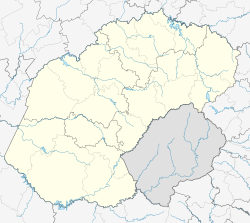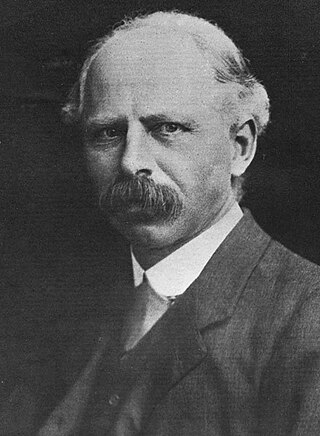
Leonard Trelawny Hobhouse, FBA was an English liberal political theorist and sociologist, who has been considered one of the leading and earliest proponents of social liberalism. His works, culminating in his famous book Liberalism (1911), occupy a seminal position within the canon of New Liberalism. He worked both as an academic and a journalist, and played a key role in the establishment of sociology as an academic discipline; in 1907 he shared, with Edward Westermarck, the distinction of being the first professor of sociology to be appointed in the United Kingdom, at the University of London. He was also the founder and first editor of The Sociological Review. His sister was Emily Hobhouse, the British welfare activist.

Castle Cary is a market town and civil parish in south Somerset, England, 5 miles (8 km) north west of Wincanton and 8 miles (12.9 km) south of Shepton Mallet, at the foot of Lodge Hill and on the River Cary, a tributary of the Parrett.
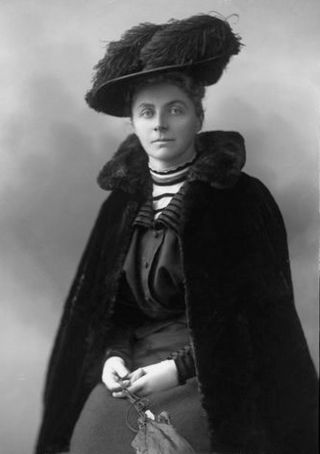
Emily Hobhouse was a British welfare campaigner, anti-war activist, and pacifist. She is primarily remembered for bringing to the attention of the British public, and working to change, the deprived conditions inside the British concentration camps in South Africa built to incarcerate Boer and African civilians during the Second Boer War.
Westonaria is a town in the west of Gauteng province of South Africa. It is situated in the Rand West City Local Municipality, part of the West Rand District Municipality. During the apartheid era, Africans lived outside town in Bekkersdal. The town is some 45 km west of Johannesburg and 18 km south of Randfontein.
Tweespruit is a small dairy farming town in the Free State province of South Africa. The town lies 27 km east of Thaba Nchu and 47 km north of Hobhouse.

Philippolis is a town in the Free State province of South Africa. The town is the birthplace of writer and intellectual Sir Laurens van der Post, actress Brümilda van Rensburg and Springboks rugby player Adriaan Strauss. It is regarded as one of the first colonial settlements in the Free State.
Halfway House Estate is a suburb of Midrand, South Africa. It is located in Region A of the City of Johannesburg Metropolitan Municipality.

The National Women's Monument in Bloemfontein, South Africa, is a monument commemorating the roughly 27,000 Boers who died in British concentration camps during the Second Boer War. The Monument is a Provincial Heritage Site in the Free State.
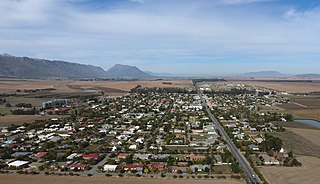
Porterville is a town in the Western Cape province of South Africa.

Prieska is a town on the south bank of the Orange River, in the province of the Northern Cape, in western South Africa. It is located on the southern bank of the Orange River, 130 km north-west of Britstown and 75 km south-east of Marydale.

SAS Umkhonto (S98), formerly SAS Emily Hobhouse, was the second of three French-built Daphné-class submarines ordered by the South African Navy in 1968. Laid down in December 1968 and launched on 24 October 1969 and commissioned into the South African Navy under the command of Lt Cdr Lambert Jackson "Woody" Woodburne on 26 February 1971. The submarine was decommissioned in 2003 and scrapped in 2008.

Elizabeth Cecilia van Zyl was a South African child inmate of the British-operated Bloemfontein Concentration Camp who died from typhoid fever during the Second Anglo-Boer War.
Bothasig is a suburban area of the City of Cape Town in Western Cape, South Africa. It is located north of Edgemead and east of Milnerton. It is located approximately 15 km north-east of the Cape Town city centre.
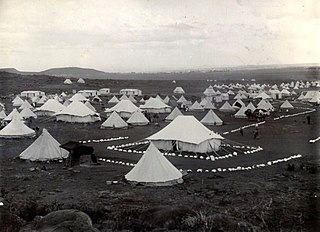
During the Second Anglo-Boer War which lasted from 1899–1902, the British operated concentration camps in the South Africa Republic, Orange Free State, Natal and the Cape Colony. In February of 1900, Herbert Kitchener took command of the British forces and implemented some of the controversial tactics that led to a British victory.

Elsburg is a town in Ekurhuleni in the Gauteng province of South Africa. It is a town some 6 km south-east of Germiston.
Thaba Phatswa is a town in Thabo Mofutsanyane District Municipality in the Free State province of South Africa.

Strandfontein is a seaside resort 8 km east of Muizenberg and just west of Michells Plain, on the northern shore of False Bay in the City of Cape Town municipality in the Western Cape province of South Africa.

Philadelphia is a village in the Western Cape province of South Africa.
SAS President Steyn was the second of three President-class Type 12 frigates built in the United Kingdom for the South African Navy (SAN) to use during the 1960s. The ship spent most of her career training and made many visits to foreign ports in Africa, Western Europe and Australia. In the late 1960s, she was modernized and equipped to operate a helicopter. In the mid-1970s, President Steyn played a minor role in the Angolan Civil War as a part of South African operations against the communists. The ship was withdrawn from service in 1980 and was sunk as a target in 1991. This happened after financial problems prevented her from being reactivated.
Isaac Hobhouse was an English slave trader, merchant, and member of the Society of Merchant Venturers. Based in Bristol, he was at the centre of money, trade, and credit and acquired much of his fortune through the trade and exploitation of African slaves in the 18th century.

